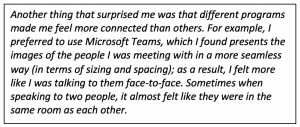In March 2020, the University of Toronto moved to an entirely online/remote teaching environment in response to the global COVID-19 pandemic. Instructors, staff and students pivoted quickly and, for some, there was a steep learning curve. This Re:Think series focuses on instructor experiences – how they connected with students and colleagues, the creative ways they approached the transition, and the challenges they faced and resources they discovered while doing so.
We asked graduate student peer trainers with the Teaching Assistants’ Training Program to share their experiences as teaching assistants, Course Instructors and TATP staff members during this time.
Matthew Patience
Course Instructor Coordinator, Teaching Assistants’ Training Program
PhD Candidate, Department of Spanish & Portuguese
An Opportunity to Share
One of my main responsibilities during the pandemic was to support graduate student TAs and Course Instructors (CI) through my role as the CI coordinator at TATP (I was also a head TA and TA for a linguistics course at UTM but will focus here on my TATP CI Coordinator role). This consisted of converting some of our workshops to online, in addition to providing consultations to CIs.
The major project I worked on was our Course Instructor Camp, which is normally a day long series of three 2-hour in-person workshops. CI camp prepares CIs for creating and teaching an upcoming course, and it counts as paid training for first time CIs, who are eligible for 6 hours of paid training. Given the importance of our CI Camp, instead of cancelling the workshop due to the pandemic, we converted it to an online format – 5 asynchronous online modules that CIs could complete on their own time, in addition to two synchronous 1.5 hour webinars. We had a lot of interest in the camp because most CIs do not have experience teaching online.
It was a huge job to convert the CI camp online, and we only had about two weeks to finish all of the content. As the CI Coordinator, I worked with 5 TATP trainers and the TATP leadership team to coordinate the conversion of the workshops to online. The size, importance, and speed with which we needed to put the project together made it a challenging experience. However, it was a very positive collaboration, and we were able to create something we were proud of, despite the very short deadline.
One thing that surprised me was that it was easier to meet with people. People were in many cases busier than before with various new responsibilities, but I found it was also generally easier to schedule meetings.
I was also pleasantly surprised that I didn’t mind the virtual meetings. In the past, I’ve always preferred in person meetings; virtual meetings were used if necessary, and I had no problem with them, but I found it easier to communicate in person. Given that in-person meetings were not an option, virtual meetings worked great, at least for smaller meetings.
Blackboard Collaborate Ultra has some useful capabilities. The breakout rooms work well and can be used as one strategy for building community, and encouraging students to interact.
Discussion boards have been very useful, too. You can adapt many activities to discussion boards, and this tool has made it possible to create and maintain dialogues at a distance and over time.
Creativity played a huge role in our switch from what would normally be our face-to-face CI camp, to our virtual CI camp. One of the strengths of this particular workshop, and something that participants always say they like, is that it is a very hands-on workshop, with many opportunities to apply the best practices we discuss.
Because we were implementing into our CI camp many of the same best practices that we were discussing and encouraging in the CI camp (e.g., how to engage students in an online environment; importance of building community online) the conversion to online was an interesting experience. This actually worked out well, because we presented material in the CI camp as a model for the best practices to our participants.
For example, CIs were concerned about how to engage in an online environment. One of the concepts that is crucial to engagement is active learning. Our asynchronous and synchronous components included various forms of active learning; these activities demonstrated to the participants some activities that they could use in their own classes, in an online environment. Many were activities that we use in face-to-face contexts (e.g., surveys, peer review, think-pair-share, quizzes); however, it was helpful to demonstrate to participants how these same activities can be incorporated online.
Another example is the asynchronous modules we created, which were built in Quercus. The modules illustrated one way in which participants could design their lessons/courses if they wanted to, with concrete examples (using the same program they would be using) that they had actually experienced as a user in the Camp.
Surprises Along the Way
I was surprised at how important the community building was in the webinars. For example, many participants commented on how they enjoyed our initial activity (they were broken into groups, then introduced themselves, shared the course they were going to teach, and shared a concern related to teaching online). Community building is crucial in an online course, but I was curious how effective an opening activity like this would be during a short webinar, given that participants likely would only engage with each other that one time. Nevertheless, many participants commented that this activity was their favorite part of the webinar.
We had the same positive response towards our peer review activity, which participants completed after splitting out to breakout rooms. The syllabus peer review is a very popular activity in our CI camp; but, we wondered, would it still work as well in an online webinar? In fact, in turns out that it was still a very popular activity, and something we will continue using in the future.
In the case of the webinar we did, it was helpful for CIs to share with their peers the concerns that they had. In many cases, they had similar concerns, which was probably reassuring to them.
I was also surprised and impressed by the level of engagement of the participants in the asynchronous component – we received many great questions and responses to our activities.
 Working with Colleagues Through the Challenges
Working with Colleagues Through the Challenges
Our team at TATP team is fantastic. I have learned so much from our leadership team and the other trainers. The different teaching approaches of my colleagues, and their different areas of expertise, help me identify areas of my own teaching that I can work on.
I always learn a lot from the students I teach (as a TA and CI), both from their feedback through evaluations (formal and informal), and from my own reflection on what works and what doesn’t. Running the CI Camp in this first online iteration has also helped identify challenges. We received some very useful feedback from our participant evaluation forms and will be working on these suggestions in future iterations of the Camp.
As we become more familiar with online education, I think students and teachers will uncover benefits we weren’t expecting. There is sometimes a resistance to moving online, and there are certainly challenges to teaching online. However, there are many advantages as well, and hopefully the rapid move to online education will help us recognize some of these.
I’ve learned that as both teachers and learners, we are still learning how to interact in an online environment. I’m looking forward to seeing how online education evolves in the future, and what it will look like as we become more adept in an online context.

























